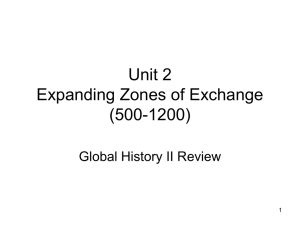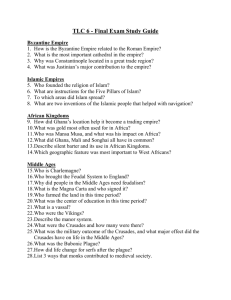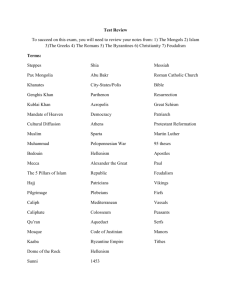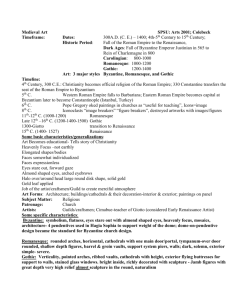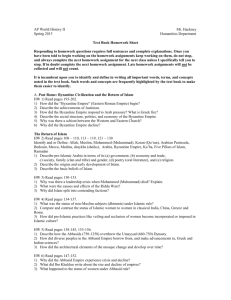CP World History Fall Final Exam Review
advertisement
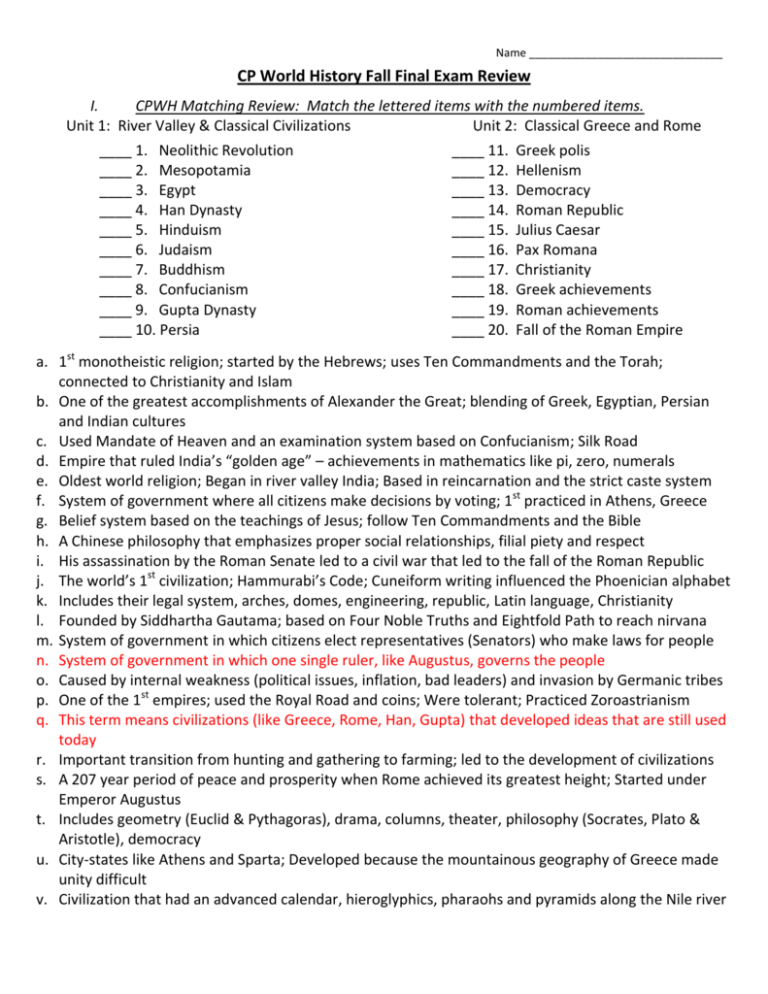
Name _______________________________ CP World History Fall Final Exam Review I. CPWH Matching Review: Match the lettered items with the numbered items. Unit 1: River Valley & Classical Civilizations Unit 2: Classical Greece and Rome ____ 1. Neolithic Revolution ____ 2. Mesopotamia ____ 3. Egypt ____ 4. Han Dynasty ____ 5. Hinduism ____ 6. Judaism ____ 7. Buddhism ____ 8. Confucianism ____ 9. Gupta Dynasty ____ 10. Persia ____ 11. ____ 12. ____ 13. ____ 14. ____ 15. ____ 16. ____ 17. ____ 18. ____ 19. ____ 20. Greek polis Hellenism Democracy Roman Republic Julius Caesar Pax Romana Christianity Greek achievements Roman achievements Fall of the Roman Empire a. 1st monotheistic religion; started by the Hebrews; uses Ten Commandments and the Torah; connected to Christianity and Islam b. One of the greatest accomplishments of Alexander the Great; blending of Greek, Egyptian, Persian and Indian cultures c. Used Mandate of Heaven and an examination system based on Confucianism; Silk Road d. Empire that ruled India’s “golden age” – achievements in mathematics like pi, zero, numerals e. Oldest world religion; Began in river valley India; Based in reincarnation and the strict caste system f. System of government where all citizens make decisions by voting; 1st practiced in Athens, Greece g. Belief system based on the teachings of Jesus; follow Ten Commandments and the Bible h. A Chinese philosophy that emphasizes proper social relationships, filial piety and respect i. His assassination by the Roman Senate led to a civil war that led to the fall of the Roman Republic j. The world’s 1st civilization; Hammurabi’s Code; Cuneiform writing influenced the Phoenician alphabet k. Includes their legal system, arches, domes, engineering, republic, Latin language, Christianity l. Founded by Siddhartha Gautama; based on Four Noble Truths and Eightfold Path to reach nirvana m. System of government in which citizens elect representatives (Senators) who make laws for people n. System of government in which one single ruler, like Augustus, governs the people o. Caused by internal weakness (political issues, inflation, bad leaders) and invasion by Germanic tribes p. One of the 1st empires; used the Royal Road and coins; Were tolerant; Practiced Zoroastrianism q. This term means civilizations (like Greece, Rome, Han, Gupta) that developed ideas that are still used today r. Important transition from hunting and gathering to farming; led to the development of civilizations s. A 207 year period of peace and prosperity when Rome achieved its greatest height; Started under Emperor Augustus t. Includes geometry (Euclid & Pythagoras), drama, columns, theater, philosophy (Socrates, Plato & Aristotle), democracy u. City-states like Athens and Sparta; Developed because the mountainous geography of Greece made unity difficult v. Civilization that had an advanced calendar, hieroglyphics, pharaohs and pyramids along the Nile river Name _______________________________ CP World History Fall Final Exam Review II. CPWH Matching Review: Match the lettered items with the numbered items. Unit 3: Islam and Africa Unit 5: The Americas, China & the Mongols ____ 1. Five Pillars of Islam ____ 2. Qur’an ____ 3. “People of the Book” ____ 4. Sunni/Shia split ____ 5. Islamic achievements ____ 6. Caliph ____ 7. Bantu ____ 8. Trans-Saharan trade ____ 9. Ghana, Mali and Songhai ____ 10. Swahili a. b. c. d. e. f. g. h. i. j. k. l. m. n. o. p. q. r. s. t. u. v. ____ 11. ____ 12. ____ 13. ____ 14. ____ 15. ____ 16. ____ 17. ____ 18. ____ 19. ____ 20. Olmecs Mayans Aztecs Inca Chinese achievements Zheng He Mongols Genghis and Kublai Khan Pax Mongolica Marco Polo Included magnetic compass, smallpox inoculation, mechanical clock, gunpowder, printing press Merchant who traveled from Italy to China and wrote his story; served in Kublai Khan’s court 1st leader of the Mongol Empire and his grandson; ruthless in battle but tolerant as rulers Guidelines for Muslims; includes profession of faith, prayer five times a day, almsgiving, hajj and fasting during Ramadan Group that migrated through Africa spreading their farming techniques, language and religion Means “cube” in Arabic; It is a holy shrine in Mecca and the focus of the Muslim pilgrims on the Hajj A disagreement over who should lead led to this split within Islam Civilization in the Andes Mountains that tightly controlled their empire, had quipu, built roads and bridges, and were polytheistic but emphasized the Sun god Blending of Arabic and Bantu languages created this language Period of peace and prosperity that included trade between Europe and Asia The transfer of ideas, culture and religion; usually happens as a result of trade or conquering Holy book of Islam Civilization that developed an accurate calendar, built pyramids, had city-states and glyphs Connection of Jews and Christians to Muslims; refers to the common beliefs, ideas and prophets of all three religions share Title given to one of Muhammad’s successors; leaders of the Islamic Empire Included algebra, chemistry, medicine (Ibn Sina), geography (Ibn Battuta), calligraphy and art Civilization centered around Lake Texcoco, built chinampas and practiced human sacrifices Exchange of gold and salt between Muslim Arabs in North Africa and West Africans Originally nomadic group of people that were able to take over Russia, the Islamic Empire, China and the central Asian steppe West African kingdoms that gained wealth from the gold-salt trade; leaders include Sundiata and Mansa Musa(who made the hajj to Mecca); center of learning at Timbuktu Sailor that led the “treasure fleet” of junks across the Indian Ocean to Africa, Arabia and India “Mother” civilization of Mesoamerica; created large head statues Name _______________________________ CP World History Fall Final Exam Review III. CPWH Matching Review: Match the lettered items with the numbered items. Unit 4: Byzantine Empire & Middle Ages Unit 6: The Renaissance and Protestant Reformation ____ 1. Constantinople ____ 2. The Justinian Code ____ 3. Orthodox Christianity ____ 4. Roman Catholicism ____ 5. Russia ____ 6. Middle Ages ____ 7. Charlemagne ____ 8. Feudalism ____ 9. Manorial System ____ 10. Crusades and the Black Death a. b. c. d. e. f. g. h. i. j. k. l. m. n. o. p. q. r. s. t. u. v. ____ 11. ____ 12. ____ 13. ____ 14. ____ 15. ____ 16. ____ 17. ____ 18. ____ 19. ____ 20. Florence Leonardo da Vinci Michelangelo Johannes Gutenberg Humanism Machiavelli Indulgences Martin Luther John Calvin Council of Trent A corrupt practice of the Catholic Church that helped lead to the Protestant Reformation A medieval economic system; Peasants farmed the land for noble lords A medieval political system; Noble lords offered protection by using castles and loyal knights A Renaissance ideal that focused on individual achievement and a belief in human potential A Renaissance ideal that valued Greco-Roman ideas and styles An 800-year era during which Western Europe lacked trade, learning, cultural diffusion Artist, inventor, scientist was a “Renaissance Man”; Painted Mona Lisa and the Last Supper Author of The Prince which gave advice to kings such as “be feared, not loved” Believed in justification by faith; Wrote the Ninety-Five Theses; He was the first “protestant” Influenced by Slavs, Vikings, and Byzantine Empire; Led by a “czar”; Used the Cyrillic alphabet Invented the moveable-type printing press; His invention lowered price of books and led to a rise in literacy throughout Europe during the Renaissance Meetings during the Counter-Reformation during which the Catholic Church ended indulgences but affirmed salvation through good works; Formed the Jesuits led by Ignatius of Loyola One of the few powerful kings during the Middle Ages; King of the Franks; Spread Christianity Painter and sculptor known for realism; Sculpted David and painted the Sistine Chapel Protestant reformer who believed in predestination; Believed in a government led by the “elect” who ruled through a theocracy Protestant reformer who broke from the Catholic Church and formed the Anglican Church The official religion of the Byzantine Empire after the Great Schism; Led by the Byzantine Emperor and the patriarch; Did not accept use of icons The official religion of Western Europe in the Middle Ages; Led by the Pope The written laws that provided order in the Byzantine Empire; Created from Roman laws Weakened the power of feudal lords; Encouraged trade and helped lead to the Renaissance Wealthy trade city that served as the capitol of the Byzantine Empire; The city preserved GrecoRoman ideas; Location of the Hagia Sophia cathedral Wealthy trade city where the Renaissance began; Home of the Medici family of bankers Name _______________________________ CP World History Fall Final Exam Review IV. CPWH Matching Review: Match the lettered items with the numbered items. Unit 7: Exploration, Absolute Monarchs, Scientific Revolution All Units ____ 1. Astrolabe and Carvel ____ 2. Prince Henry ____ 3. Vasco daGama ____ 4. Ferdinand Magellan ____ 5. Mercantilism ____ 6. Columbian Exchange ____ 7. Louis XIV ____ 8. Peter the Great ____ 9. Magna Carta ____ 10. Newton, Copernicus, Galileo ____ 11. ____ 12. ____ 13. ____ 14. ____ 15. ____ 16. ____ 17. ____ 18. ____ 19. ____ 20. River Valley Civilizations Classical Civilizations Islamic Empire Byzantine Empire Middle Ages Mesoamerican Societies Tang and Song Dynasties Mongols Renaissance Protestant Reformation a. Absolute monarch of Russia; Began a massive program to “westernize” Russia b. An 800 year era in Western Europe after the fall of Rome; Feudalism; Manorial system c. Began in Mecca and conquered Arabia, North Africa, Persia; Led by caliphs; Developed chemistry and algebra d. Created a navigation school in Portugal; Portuguese explorers led to Age of Exploration e. Created gunpowder, magnetic compass, paper money; moveable-type printing; Began to actively trade with foreigners f. Criticisms of the Catholic Church led to new Christian religions under Luther, Calvin, Henry VIII g. Devil’s horsemen; Largest land empire in history; Protected the Silk Road; Tolerant rulers h. Economic theory that encouraged European nations to create colonies; The idea was that the mother country in Europe should use colonies to create a favorable balance of trade i. Absolute monarch of France; “Sun King” ruled France for 72 years; Build Versailles j. Greece, Rome, Han China, Gupta India k. Introduction of European goods and ideas(horses, grains, diseases) to America and the introduction of New World goods (potatoes, corn, tobacco) to Europe l. Limited monarch in England who had to work with Parliament; Virgin Queen; Ruled for 45 years m. Mayans had an accurate calendar and glyphic writing; Aztecs had chinampas and sacrifices n. Mesopotamia, Egypt, India, China o. Navigation device and new ship design that provided the technology to allow exploration p. Portuguese explorer who first traveled around Africa to find a new route to Asia q. Rebirth of learning, trade, trade; Perspective, realism in art; Secular topics in literature r. Scientists who used logic and reason to develop new understandings of gravity and solar system s. The first document to limit the power of the English monarch; Led to the creation of Parliament t. Trade route that brought slaves from West Africa to the American colonies u. The first explorer to lead an expedition to circumnavigate the world v. The Justinian Code; Eastern Orthodox Christians; Hagia Sophia; Capital at Constantinople Answer Key I. River Valley Civilizations and Classical Greece and Rome 1. R 2. J 3. V 4. C 5. E 6. A 7. L 8. H 9. D 10. P 11. U 12. B 13. F 14. M 15. I 16. S 17. G 18. T 19. K 20. O II. Islam, Africa, The Americas, China and the Mongols 1. D 2. L 3. N 4. G 5. P 6. O 7. E 8. R 9. T 10. I 11. V 12. M 13. Q 14. H 15. A 16. U 17. S 18. C 19. J 20. B III. Byzantine, Middle Ages, Renaissance & Reformation 1. U 2. S 3. Q 4. R 5. J 6. F 7. M 8. C 9. B 10. T 11. V 12. G 13. N 14. K 15. D 16. H 17. A 18. I 19. O 20. L IV. Exploration, Scientific Revolution, All Units 1. O 2. D 3. P 4. U 5. H 6. K 10. R 11. N 12. J 13. C 14. V 15. B 16. M 18. G 19. Q 20. F
